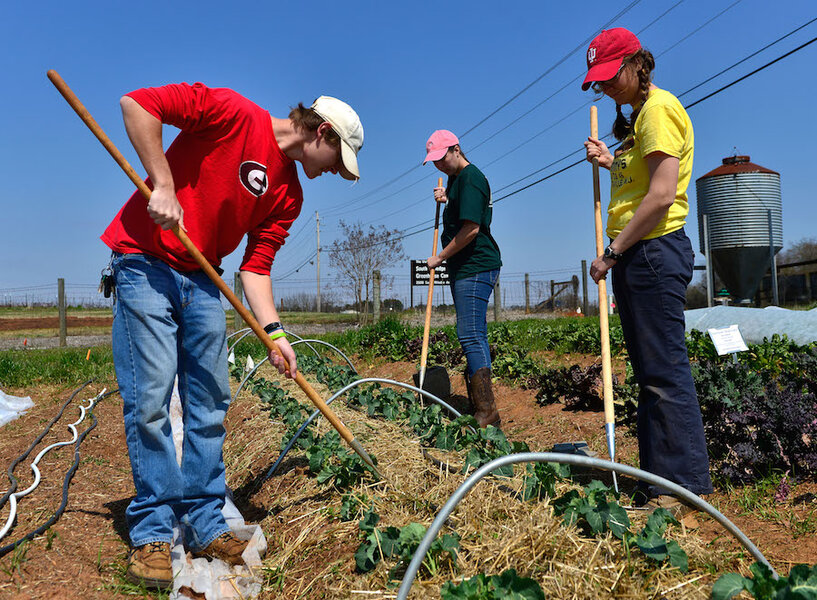Ten things we can all do to support a local food system
Loading...
Supporting local food systems has an array of benefits: it can strengthen local economies and communities, aid local small-scale farmers, preserve open spaces, benefit the environment, and help ensure community farms will still be there tomorrow— just to name a few. Food Tank highlights 10 ideas to support local food systems.
Choose restaurants that source foods locally and support workers. Eating locally doesn’t have to stop when you leave your kitchen. Many chefs source at least some, if not all, of their ingredients locally. Try Sustainable Table’s Eat Well Guide or the Restaurant Opportunities Centers United’s Diners’ Guide to Ethical Eating. Alternately, go directly to restaurant websites and online menus, or call to speak with an employee to learn which of the restaurants in your neighborhood source foods from local farmers.
Embrace biodiversity. Find out which foods are your region’s specialties and try those rarer varieties. Instead of factory-farmed Broad Breasted White turkeys, for instance, find a heritage breed unique to your area and discover a wonderful array of new flavors. Choosing local varieties is not only good for the local food system, but also helps preserve genetic diversity. Slow Food’s Ark of Taste can help you discover what types of foods are unique to where you live.
Look for local brands in stores, using resources like the Eat Well Guide. Buying locally produced items from grocery stores, sometimes in lieu of the farmers market, can ensure that local products stay on the shelves—and may lead to grocers stocking even more options. If you don’t want to offend your farmer, make sure to emphasize that you still love the farm’s products, and will continue your support by purchasing his or her wares at your neighborhood food stores.
Make suggestions. If your local supermarkets don’t stock locally-sourced foods, ask. Tell your friends to ask, too. Store owners want to provide customers with in-demand products, and respond well to consumer suggestions. If there is enough call for local products, owners will be more likely to bring these items into stores.
Plan your menus around what’s being harvested. Even if everything you buy isn’t produced in your community, you still contribute to the local food system by building seasonal foods into your recipes. In colder months, swap the heat-loving basil in pesto for a winter green like kale or beet greens. Switch the peppers, zucchini, and tomatoes in your summertime pasta primavera for broccoli, cauliflower, and Brussels sprouts in fall.
Preserve. If you live somewhere with cold winters, you may not have many local produce options for a good portion of the year. Make eating locally easier during these less bountiful months by buying up products you love while they’re in season and preserving them—pickling, canning, drying, jellying, and freezing are a few common methods.
Sign up for Community Supported Agriculture (CSA) to receive a share of fresh produce from a local farm, usually on a weekly or bi-weekly basis. To join, customers pay a farmer for shares at the beginning of the season. This is extremely helpful for producers, as farms incur many of the costs associated with farming before the season even begins—like buying and planting seeds, or paying workers to prepare the land. Additionally, by joining a CSA, you share in the inherent risks of the agricultural season, helping to guarantee farmers the necessary financial support each growing season.
Try the less popular crops that are necessary for healthy soil and a successful farm. Dan Barber, renowned chef and author, explains in the The New York Times that by “celebrating the All-Stars of the farmers market—asparagus, heirloom tomatoes, emmer wheat—farm-to-table advocates are often guilty of ignoring a whole class of humbler crops that are required to produce the most delicious food.” Rotating in the more modest beans and mustard seed creates the fertile soil required for high-demand crops. When unable to sell these less popular foods, farmers must dedicate the crops to alternative purposes, such as animal feeds, and lose profits. Talk to farmers and learn which supporting crops their land needs, then incorporate these different foods into your diet.
Volunteer. Many small-scale farms can use a little extra help with a variety of tasks around the property. Volunteering at a local farm can enable you to learn more about your local agriculturalist and the work they do every day, while building lasting relationships and giving back to your local food system. There are international organizations—such as Worldwide Opportunities on Organic Farms (WWOOF)—that facilitate volunteering on sustainable farms, as well as social activism organizations—such as DoSomething—that provide volunteering opportunities. Alternatively, speak to the farmers at your local market to find an outfit in need of assistance.







